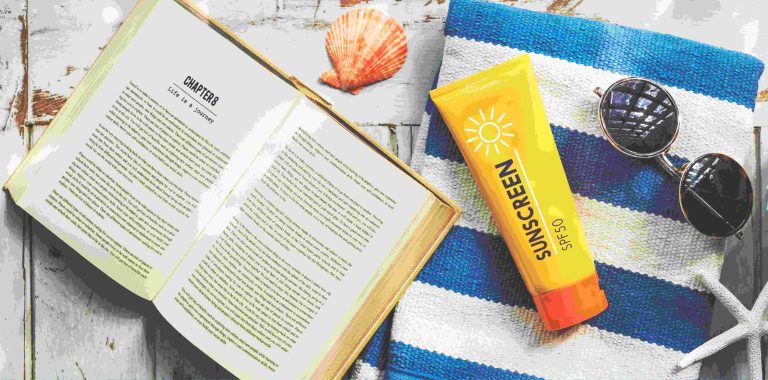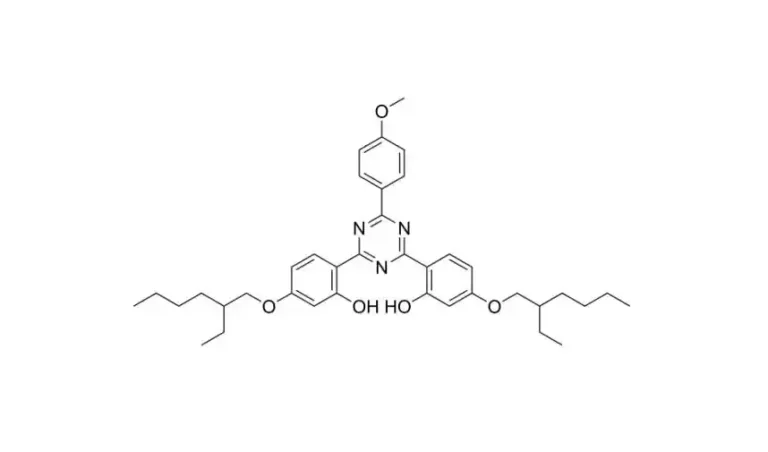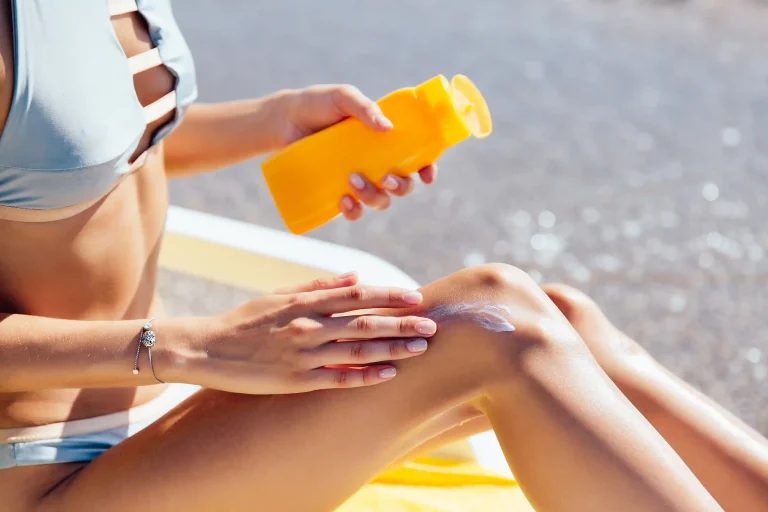Химическая структура и функциональность Октаокрилен
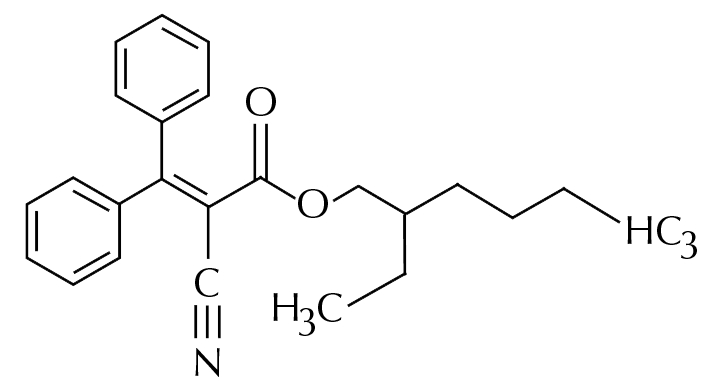
Октаокрилен является липофильным солнцезащитным кремом, используемым в солнцезащитных кремах и других продуктах личной гигиены. Октокрилен является в первую очередь защитником от ультрафиолетового излучения с слабой защитой от ультрафиолетового излучения. В результате своих химических свойств октокрилен может быть использован для стабилизации других ингредиентов солнечной формулы, особенно авобенцона, снижая скорость их разложения при воздействии солнечного излучения. Октокрилен’ Фотостабильность делает его отличным производителем в широкоспектральных продуктах солнечной защиты, предназначенных для долгосрочной солнечной защиты.
Преимущества октокрилена как сырья для солнцезащитных кремов
Октокрилен повышает водостойкость солнцезащитных кремов и обеспечивает им нежирную, гладкую текстуру. Октокрилен иначе инертен с любым другим косметическим компонентом и может безопасно использоваться в спреях, гелях, лосьонах и кремах. Октокрилен обеспечивает защиту от солнечных ожогов и повреждений кожи, вызванных коротковолнным ультрафиолетовым излучением, посредством поглощения ультрафиолетового излучения.
Общее применение и формы продукта, которые используют октокрилен
Октокрилен также встречается в высоких уровнях концентрации в солнцезащитных кремах для тела, солнцезащитных кремах для лица, SPF-содержащих антиморщинных увлажняющих кремах и оттенченных увлажняющих кремах, а также в некоторых косметических продуктах. Его фотостабильность является одной из причин, почему он является актуальным выбором ингредиентов для продуктов для ухода за солнцем с длительным воздействием УФ.
Механизмы раздражения кожи, связанные с октокриленом
Взаимодействие с функцией кожного барьера
Хотя безопасно для всех в целом, октокрилен является раздражителем кожи для тех, кто имеет сломанные кожные барьеры. Когда кожный барьер нарушается из-за сухости, покраснения или чрезмерной эксфолиации, химические вещества, такие как октокрилен, проникают легче и являются причиной раздражения или аллергического контактного дерматита.
Фотостабильность и образование побочных продуктов при ультрафиолетовом воздействии
В то время как октокрилен стабилизирует другие солнцезащитные средства, такие как авобенцон, они распадаются после периода воздействия ультрафиолетового излучения. Распад, скорее всего, приведет к образованию бензофенона, что является проблематичным, поскольку он, скорее всего, будет обнаружен аллергенным происхождением. Эти побочные продукты будут накапливаться и, скорее всего, будут способствовать развитию усиленного задержки аллергического контактного дерматита у уязвимых людей.
Факторы, которые могут повысить чувствительность или реакцию
Тип кожи является фактором, влияющим на то, как человек будет реагировать на октокрилен. Также вводится в комбинацию повторное воздействие, окружающая тепла и влажность, а также ранее существующие условия, такие как розацея или экзема - все это способствует повышенной уязвимости к раздражительности.
Классификация и особенности типов кожи
Нормальная кожа
Содержит масло и равновесие влаги; редко раздражает или шерстит.
Сухая кожа
отсутствие или минимальное количество натуральных масел; лушки, плотные и более чувствительные.
жирная кожа
У него слишком много маза; обычно сопровождаются большими порами и акне-подобной кожей.
Комбинированная кожа
Он имеет масляные (обычно Т-зоны) и сухие участки на остальной части лица.
Чувствительная кожа
чувствительность к раздражению продукта или окружающей среды; чувствительность к покраснению или колу при контакте с продуктами.
Как различные типы кожи реагируют на октокрилен
Реакции, которые можно наблюдать у чувствительных типов кожи
Чувствительная кожа наиболее склонна к потенциальному раздражению продуктов октокрилена из-за ее непереносимости. Красность, раздражение, зуд или даже легкое жжение при применении могут вызвать симптомы.
Уровни толерантности в жирной и комбинированной коже
Комедогенная и жирная кожа обычно не является проблемой для октокрилена, потому что их естественный масляный слой является какой-то формой барьера для химического проникновения. Закрытие пор продуктами, содержащими этот ингредиент в высокой концентрации, следует избегать в коже угре.
Влияние на сухую и обезвожившую кожу
Сухая кожа содержит нарушенный липидный барьер и, следовательно, более восприимчива к раздражению. У этих пользователей октокрилен будет шерстчать или высохнуть, если не сопровождаться эммультирующими активными веществами, которые восстанавливают барьерную функцию.
Другие факторы, которые могут повлиять на потенциал раздражения
Существующие состояния кожи (например, экзема, розацея)
Люди с розацеей или экземой, скорее всего, будут более реактивными, потому что предрасположенная и уже воспаленная кожа обеспечивает портал входа для повышенной проникаемости раздражителей, таких как октокрилен.
Длительность и частота использования
Повторное ежедневное обычное использование на ежедневной основе в течение длительных периодов времени равно кумулятивному воздействию, потенциально увеличивающему вероятность аллергической реакции или чувствительности, даже когда присутствуют другие реактивные ингредиенты.
Более высокие температуры и влажность будут способны увеличить скорость поглощения продукта в кожу, а также улучшить любую фотохимическую реакцию, которая происходит при солнечном облучении.
Хаки для минимизации раздражения продуктов на основе октокрилена
Выбор лучшего солнцезащитного крема для вашей кожи
Тестирование патча перед расширенным использованием
Смешивание с ингредиентами для ухода за кожей, восстанавливающими барьеры
Альтернатива для чувствительной кожи
Если химические фильтры, такие как октокрилен, раздражают вас, замените их фильтрами на минеральной основе, которые славятся успокаивающими болезненную кожу.
Физические фильтры сидят на поверхности кожи и не поглощаются. Они отражают ультрафиолетовый свет физически далеко от кожи, а не химически поглощают его, что делает их отличным выбором для тех, кто может иметь возможности раздражения с помощью химических фильтров.
Регулирующие позиции и оценки безопасности использования октокрилена
Международный нормативный статус и концентрация в формуле
Международные регулирующие органы, такие как FDA (США), SCCS (ЕС) и здравоохранение Канады одобрили использование октокрилена в пределах концентраций формулы - обычно 10% - после оценки безопасности, проведенной посредством токсикологических обследований.
Продолжающиеся долгосрочные исследования безопасности и аллергичности
Недавние исследования привели к усилению наблюдения за хроническим риском воздействия химических побочных продуктов деградации, таких как бензофенон. Хотя информация в настоящее время соответствует общей безопасности при пороговых концентрациях, по-прежнему существуют дополнительные исследования по аллергической чувствительности в группах риска.
Почему выбрать BFP Новый материал
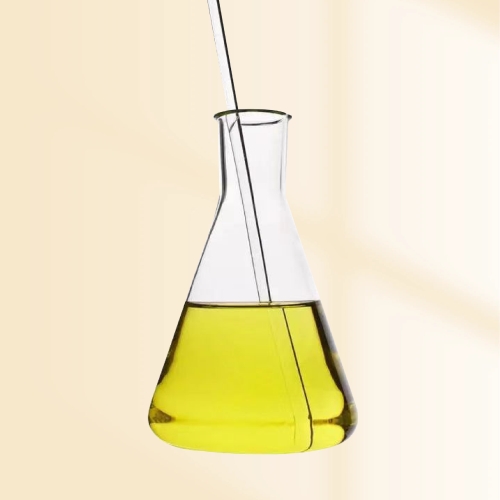
BFP New Material основан на высококачественном сырье для всей косметики и специально разработанных решениях для ваших потребностей в формуле. Независимо от того, вводите ли вы серию продуктов для ухода за солнцем, не содержащих фильтров с высоким раздражением, таких как октокрилен, или требующих стабильных эмульгаторов, совместимых с минеральными фильтрами, такими как оксид цинка, мы настроили соответствие ингредиентов для удовлетворения требований ваших целевых рынков.
Наши решения:
Настройчивые смеси ультрафиолетовых фильтров
Чувствительные поверхностно-активные вещества для составления продукта для чувствительной кожи
Солнцезащитные эмульгаторы для водостойких систем, специально разработанные
Международно признанные консервативные системы
Мы помогаем R& Группы D по всему миру с технической поддержкой документации и рекомендацией формулы для каждого заказа — каждая партия соответствует вашим спецификациям через нашу индивидуальную программу обслуживания.
О нас
Шанхай BFP New Material CoLtd является компанией, которая фокусируется на анти-старения сырья для ухода за солнцем и некоторых промышленных приложений. Продукт в основном включает в себя УФ-абсорбиторы, органические УФ-фильтры, минеральные УФ-фильтры (нано и ненано диоксид титана, оксид цинка, дисперсивная жидкость и индивидуальные продукты), отбеливающие порошки и антиоксиданты, с использованием этих продуктов мы стремимся улучшить и продлить внешний вид и функция людей и конечных продуктов, чтобы сделать нашу жизнь более замечательной.
Наши производственные площадки находятся в разных частях Китая, в настоящее время мы представляем в провинции Tianjin, Shandong, Jiangsu и Hubei для производства различных серий продуктов, все эти растения находятся в химическом парке с чистым мастерской, а некоторые - сертифицированные GMP, оснащенные расширенными лабораторными оборудованием, у нас есть профессиональная R & D, а команда QC обеспечивает обеспечение качества продукции, и продукты могут удовлетворить качество продукции.
factory.png
Для технических данных, образцов или помощи в формулировании с BFP-SP-M, напишите на SHBFPL’ с команда технической поддержки для персонализированного обслуживания.
Часто задаваемые вопросы
В: Безопасен ли октокрилен для ежедневного использования?
А: Да, при использовании в небольших количествах (до 10%), он практически безвреден; Однако, кто-то с чувствительной кожей должен быть осторожным и следить за чувствительностью при длительном использовании из-за риска кумулятивного воздействия.
В: Могу ли я использовать октокриленовые солнцезащитные кремы, если у меня экзема?
В идеале, сначала посетите дерматолога, поскольку экзема нарушает функцию кожного барьера, и люди с большей вероятностью будут чувствительны к некоторым химическим солнцезащитным кремам, таким как октокрилен.
В: Каковы предупредительные знаки, что я’ У меня плохая реакция на солнцезащитный крем?
О: Обычными признаками и симптомами являются покраснение, зуд, кол при контакте или задержка сыпи при воздействии солнца, указывающая на потенциальный аллергический контактный дерматит.
В: Существуют ли более безопасные альтернативы октокрилену?
О: Да - физические солнцезащитные кремы, такие как оксид цинка, являются хорошими вариантами, особенно предназначенными для младенцев или аллергических потребителей, поскольку они не проникают через кожу и не образуют реактивных побочных продуктов после воздействия солнца.
В: Предоставляет ли BFP New Material ингредиенты солнцезащитного крема для чувствительной кожи?
О: Да, у нас есть индивидуальные варианты ингредиентов, начиная от нераздражающих эмульгаторов до минерально-поддерживающих активных веществ, которые хорошо работают с чувствительными кожными линиями, привлекательными для чувствительных потребителей.

